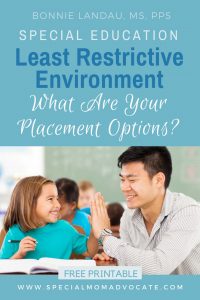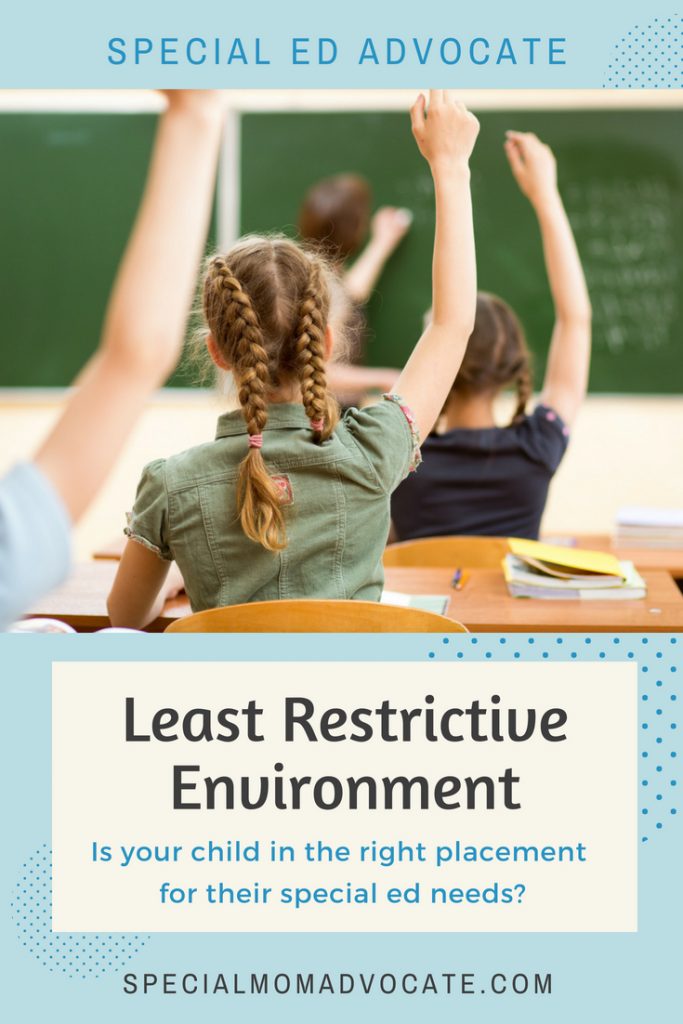 When providing an IEP, least restrictive environment (LRE) is an important concept for parents to understand. It relates to where they put your child for the daily classroom, and how much structure there is in your child’s educational day.
When providing an IEP, least restrictive environment (LRE) is an important concept for parents to understand. It relates to where they put your child for the daily classroom, and how much structure there is in your child’s educational day.
IDEA defines the LRE as: “To the maximum extent appropriate, children with disabilities, including children in public or private institutions or other care facilities, are educated with children who are not disabled, and special classes, separate schooling, or other removal of children with disabilities from the regular educational environment occurs only when the nature or severity of the disability of a child is such that education in regular classes with the use of supplementary aids and services cannot be achieved satisfactorily”
This comes from section 20 USC 1412(5)(B) of the IDEA.
LRE From Least to Most Restrictive
The following list shows you the various placement options for students in public school. They are listed in order from least restrictive to most restrictive.
1. Mainstreamed in General Education
This is for a typical student or a student with disabilities who only requires accommodations in a regular classroom.
2. General Education with Push/Pull Services
This is for a student with a 504 or IEP who does the majority of their schoolwork in the general education setting. For push services, a service provider comes into the classroom to provide extra support for the student (such as an aide). For pull services, the student is pulled from the classroom during the school day for more intensive instruction (like resource) or therapies (like speech).
3. Special Day Class
This is for a student who is not capable of functioning in a general education classroom. They are provided daily instruction usually in one single classroom with more intensive educational support and services. These students are sometimes mainstreamed into general education classes for subjects such as art or physical education. Students with severe developmental delay or cognitive delay are often placed in a special day class. Special day classes are usually categorized as mild need, moderate need and severe need. The curriculum in special day classes is significantly modified so students are not usually doing grade level work.
4. Therapeutic Learning Class
This is for a student who has severe behavioral or emotional challenges and cannot function in a general education classroom. This may be a student who has difficulty controlling anger, or students who deal with anxiety and depression and find it impossible to function in a general education setting. These classes have specialized therapists and teachers on staff who provide support to the students throughout the school day.
5. Non-Public School
If the student cannot function in any of the placements offered by the school, the student may then be put into a non-public school placement. This is usually a private school that provides specialized schooling that can better address the needs of the student. NPS placement is one of the most difficult LRE to obtain for a student since it usually requires substantial cost for the school district.
6. Home Hospital
For students who have serious physical or mental disabilities, home hospital may be the placement chosen. In some cases it is temporary, such as an accident that causes serious injuries that will heal. Sometimes it is for students who have serious health issues which make school attendance difficult, such as a student who has rheumatoid arthritis and in too much pain to attend school. Usually the student is able to do their regular schoolwork, and a tutor comes to the home several times a week to provide instruction.
7. Residential Treatment Center
For students who suffer from severe emotional disturbance, they may be placed in a residential treatment center where they will receive academic instruction as well as intensive social/emotional support. These facilities are usually staffed with doctors, therapists as well as instructors who have specialized training in working with students with these challenges.
It is important to understand Educational Placement
Knowing what each placement option provides is very important, but it is equally important to understand what the child will not get in certain placements. For example, in special day classes your child may not have any time interacting with typical same-age peers. For home hospital your child may not receive the same level of instruction as if they were in school.
Understanding the benefits and drawbacks of each placements helps you choose what is the right educational setting for your child. You are part of the IEP team so you get to help make this decision. Once a placement is made, it is often difficult to get it changed. So if the team is suggesting a change in educational setting, do your research to ensure that it really is the right environment for your child.
ABOUT THE AUTHOR:
Bonnie Landau is a professional counselor and holistic therapist in Ventura County, California. Her specialities include therapy for autism, therapy for ADHD, and therapy for parenting who have kids with autism or ADHD or other neurodivergence. She changed careers from graphic design to counseling with the goal of helping struggling parents of kids with ADHD, autism, or other neurodivergence find strategies and solutions to help their children succeed. Bonnie is also the author of Special Ed Mom Survival Guide: How to Prevail in the Special Education Process and Find Life-long Strategies for You and Your Child.



